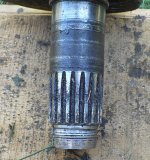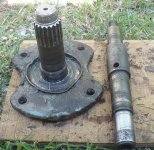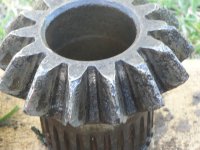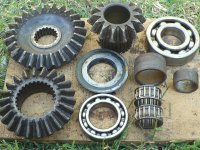bobidy
Member
Hi guys,
Here is an update on a prior post I made about obtaining no longer available gears and the rebuilding of the lf stub axle & pinion assembly on a 1610D I just purchased used. (not a "new" refurb) Also, let me say that I am a novice when it comes to all things 'tractor' So some of my assumptions & observations may be flat out wrong or, a--backwards. So please, feel free to educate me.
I'll break this down into 2 parts: the repair; and some questions & observations about same.
First off, I was able to obtain very good quality salvage gears and sleeves from Hoye and an offer of the same from Danny1. The rest of the parts needed including, the spindle and stub axle are availible new & were purchased from Hoye.
Total cost of parts for a rebuild of the left pumpkin/knuckle from the bevel gearcase bevel gear down, = $841.36 + shipping. w/an additional 500.00 + for service & Parts manuals, 2 frt tires, voltage regulator, valve cvr gasket, some decals and shipping. (ouch)!
The actual repair; if I did it correctly, was pretty easy. As the front drive and related components are in sections, easily accessed & can be removed and repaired one at a time.
I started from the pinion down in case I needed to shim and adjust free play as i went. only gear I found that seemed to need shimming was the final gear on the stub axle. I shimmed it to where there was a slight amount of free play between the teeth of it and those of the gear above. I'm hoping that's all that was needed? if I missed anything let me know as I have no previous experience at this.
I used a hammer, and the old final pinion gear and stub axle sleeve as a driver to install the new bearings onto the stub axle and into the housing. The pinion bearings were not as hard to install and only required light tapping with a punch to seat them onto the ring gear & pinion and into the housing. The knuckle seals also were easy to remove and install. Having a parts diagram made assembling the parts in the proper order easy.
After getting everything installed and reasembled, the hub felt good, had no play in or out, & all gears turned freely. It has been 3 days since the repair & I spent some time mowing on a field with no noise or leaks. I plan on pulling and re-inspecting everything later. Below are some pictures of the drive parts I replaced. It is hard to see how worn these parts really are as they dont look too bad in the pics.
Questions & observations:
when I pulled the drive parts on the lf everything was rusty & corroded & the upper housing was coated with gunk that had a lot of moisture in it. I also noted that the oil that I had drained out of the knuckle was not enough to fill it, & it contained a lot of moisture also. The rt knuckle contained twice the amount oil as the left, & the oil was clean & all gears looked great. Same for the diff.
Somehow that did not click with me at the time.
So, i went in and ordered the parts I would need. Later while cleaning up the housing in preparation for the new parts. I found that the lf bevel pinion gear/axle assembly had a sealed bearing behind the gear. That seemed to explain why the gears were in such a bad state & why there was not much oil in the knuckle
Wont a sealed bearing stop the flow of oil to any components past it if no other passage is provided ? If that is correct, then what about the sleeve on the stub axle as the new bearings supplied for replacement are sealed. Shouldn't the sleeve have some sort of lubrication ? (I decided whether it did or didn't I would fill the sleeve space between the bearings with a mix of grease and oil b4 i drove the final stub axle bearing into place) If a sealed bearing indeed stops oil flow then why are they being offered as a replacement, availability, what?
When I refilled the axle with oil the rt side filled pretty quick with oil running out of the lower bleed port in just a few minutes i continued to fill till the dip stick indicated the axle was full, waited awhile and checked the level again. It did not appear to have dropped any so i removed the bleed hole bolt on the left side and waited about 30 min, no oil and no change in the level.
So, my workaround was to fill the lower knuckle thru the bleed port (using and old outboard motor gear oil bottle) then move up to the upper port and fill till oil ran back out then stopped. I then reopened the lower port and drained a little oil to make sure there was some air space in the pinion area in case the oil might expand after heating up thru use. Sound ok to you ?
Hope I have not missed something and went thru a bunch of crap for nothing and embarrassed myself, but I wanted to make sure my repair was lubed, and I was unable to post to ask during the repair. I have some other questions on tractors in general and mine in particular but i will post them later.
Bob.
Here is an update on a prior post I made about obtaining no longer available gears and the rebuilding of the lf stub axle & pinion assembly on a 1610D I just purchased used. (not a "new" refurb) Also, let me say that I am a novice when it comes to all things 'tractor' So some of my assumptions & observations may be flat out wrong or, a--backwards. So please, feel free to educate me.
I'll break this down into 2 parts: the repair; and some questions & observations about same.
First off, I was able to obtain very good quality salvage gears and sleeves from Hoye and an offer of the same from Danny1. The rest of the parts needed including, the spindle and stub axle are availible new & were purchased from Hoye.
Total cost of parts for a rebuild of the left pumpkin/knuckle from the bevel gearcase bevel gear down, = $841.36 + shipping. w/an additional 500.00 + for service & Parts manuals, 2 frt tires, voltage regulator, valve cvr gasket, some decals and shipping. (ouch)!
The actual repair; if I did it correctly, was pretty easy. As the front drive and related components are in sections, easily accessed & can be removed and repaired one at a time.
I started from the pinion down in case I needed to shim and adjust free play as i went. only gear I found that seemed to need shimming was the final gear on the stub axle. I shimmed it to where there was a slight amount of free play between the teeth of it and those of the gear above. I'm hoping that's all that was needed? if I missed anything let me know as I have no previous experience at this.
I used a hammer, and the old final pinion gear and stub axle sleeve as a driver to install the new bearings onto the stub axle and into the housing. The pinion bearings were not as hard to install and only required light tapping with a punch to seat them onto the ring gear & pinion and into the housing. The knuckle seals also were easy to remove and install. Having a parts diagram made assembling the parts in the proper order easy.
After getting everything installed and reasembled, the hub felt good, had no play in or out, & all gears turned freely. It has been 3 days since the repair & I spent some time mowing on a field with no noise or leaks. I plan on pulling and re-inspecting everything later. Below are some pictures of the drive parts I replaced. It is hard to see how worn these parts really are as they dont look too bad in the pics.
Questions & observations:
when I pulled the drive parts on the lf everything was rusty & corroded & the upper housing was coated with gunk that had a lot of moisture in it. I also noted that the oil that I had drained out of the knuckle was not enough to fill it, & it contained a lot of moisture also. The rt knuckle contained twice the amount oil as the left, & the oil was clean & all gears looked great. Same for the diff.
Somehow that did not click with me at the time.
So, i went in and ordered the parts I would need. Later while cleaning up the housing in preparation for the new parts. I found that the lf bevel pinion gear/axle assembly had a sealed bearing behind the gear. That seemed to explain why the gears were in such a bad state & why there was not much oil in the knuckle
Wont a sealed bearing stop the flow of oil to any components past it if no other passage is provided ? If that is correct, then what about the sleeve on the stub axle as the new bearings supplied for replacement are sealed. Shouldn't the sleeve have some sort of lubrication ? (I decided whether it did or didn't I would fill the sleeve space between the bearings with a mix of grease and oil b4 i drove the final stub axle bearing into place) If a sealed bearing indeed stops oil flow then why are they being offered as a replacement, availability, what?
When I refilled the axle with oil the rt side filled pretty quick with oil running out of the lower bleed port in just a few minutes i continued to fill till the dip stick indicated the axle was full, waited awhile and checked the level again. It did not appear to have dropped any so i removed the bleed hole bolt on the left side and waited about 30 min, no oil and no change in the level.
So, my workaround was to fill the lower knuckle thru the bleed port (using and old outboard motor gear oil bottle) then move up to the upper port and fill till oil ran back out then stopped. I then reopened the lower port and drained a little oil to make sure there was some air space in the pinion area in case the oil might expand after heating up thru use. Sound ok to you ?
Hope I have not missed something and went thru a bunch of crap for nothing and embarrassed myself, but I wanted to make sure my repair was lubed, and I was unable to post to ask during the repair. I have some other questions on tractors in general and mine in particular but i will post them later.
Bob.



